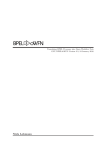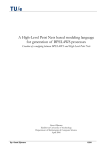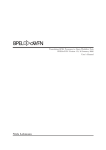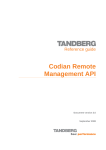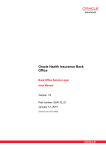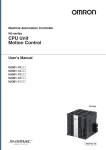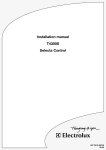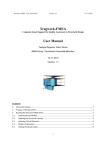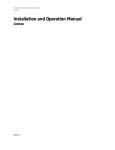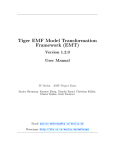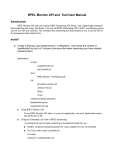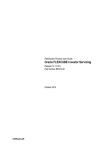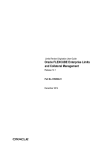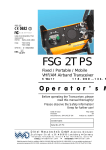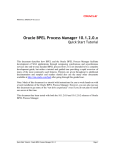Download 2.0.x
Transcript
Translating BPEL Processes into Open Workflow Nets
GNU BPEL2oWFN Version 2.0.2, 15 June 2007
User’s Manual
Niels Lohmann
About this document:
This manual is for GNU BPEL2oWFN, version 2.0.2, a tool translating a BPEL process into an
open workflow net (oWFN), last updated 15 June 2007.
c 2005, 2006, 2007 Niels Lohmann
Copyright Permission is granted to copy, distribute and/or modify this document under the
terms of the GNU Free Documentation License, Version 1.2 or any later version
published by the Free Software Foundation; with no Invariant Sections, with the
Front-Cover Texts being “A GNU Manual,” and with the Back-Cover Texts as in
(a) below. A copy of the license is included in the section entitled “GNU Free
Documentation License.”
(a) The FSF’s Back-Cover Text is: “You have freedom to copy and modify this
GNU Manual, like GNU software.”
This manual does not explain how to setup or install GNU BPEL2oWFN. For this information
please read the Installation Manual which is part of the distribution, or can be downloaded
from the website of GNU BPEL2oWFN, http://www.gnu.org/software/bpel2owfn.
GNU BPEL2oWFN was developed during the Tools4BPEL project funded
by the German Federal Ministry for Education and Research (BMBF), see
http://www.informatik.hu-berlin.de/top/tools4bpel for details.
i
Table of Contents
1
Introducing BPEL2oWFN . . . . . . . . . . . . . . . . . . . . . . . . . . . . . . . . . . . . 1
1.1
2
Concepts of BPEL2oWFN . . . . . . . . . . . . . . . . . . . . . . . . . . . . . . . . . . . . . . . . . . . . . . . . . . . . . . . . . 1
Invoking BPEL2oWFN . . . . . . . . . . . . . . . . . . . . . . . . . . . . . . . . . . . . . . . 3
2.1
Options . . . . . . . . . . . . . . . . . . . . . . . . . . . . . . . . . . . . . . . . . . . . . . . . . . . . . . . . . . . . . . . . . . . . . . . . . . .
2.1.1 Modes . . . . . . . . . . . . . . . . . . . . . . . . . . . . . . . . . . . . . . . . . . . . . . . . . . . . . . . . . . . . . . . . . . . . . . . .
2.1.2 Additional parameters . . . . . . . . . . . . . . . . . . . . . . . . . . . . . . . . . . . . . . . . . . . . . . . . . . . . . . . .
2.1.3 Output formats . . . . . . . . . . . . . . . . . . . . . . . . . . . . . . . . . . . . . . . . . . . . . . . . . . . . . . . . . . . . . . .
2.2 Exit Values . . . . . . . . . . . . . . . . . . . . . . . . . . . . . . . . . . . . . . . . . . . . . . . . . . . . . . . . . . . . . . . . . . . . . . . .
2.3 Examples . . . . . . . . . . . . . . . . . . . . . . . . . . . . . . . . . . . . . . . . . . . . . . . . . . . . . . . . . . . . . . . . . . . . . . . . .
3
4
5
6
7
8
3
Warnings and Error Messages . . . . . . . . . . . . . . . . . . . . . . . . . . . . . . . . 9
4
File Formats . . . . . . . . . . . . . . . . . . . . . . . . . . . . . . . . . . . . . . . . . . . . . . . . . . 17
5
FAQ and Known Bugs . . . . . . . . . . . . . . . . . . . . . . . . . . . . . . . . . . . . . . . 21
5.1
5.2
5.3
5.4
5.5
Frequently Asked Questions . . . . . . . . . . . . . . . . . . . . . . . . . . . . . . . . . . . . . . . . . . . . . . . . . . . . . .
Known Bugs . . . . . . . . . . . . . . . . . . . . . . . . . . . . . . . . . . . . . . . . . . . . . . . . . . . . . . . . . . . . . . . . . . . . .
Reporting Bugs . . . . . . . . . . . . . . . . . . . . . . . . . . . . . . . . . . . . . . . . . . . . . . . . . . . . . . . . . . . . . . . . . .
Contact Person . . . . . . . . . . . . . . . . . . . . . . . . . . . . . . . . . . . . . . . . . . . . . . . . . . . . . . . . . . . . . . . . . . .
Help BPEL2oWFN . . . . . . . . . . . . . . . . . . . . . . . . . . . . . . . . . . . . . . . . . . . . . . . . . . . . . . . . . . . . . . .
Appendix A
21
21
21
22
22
GNU Free Documentation License . . . . . . . . . . . . . 23
Chapter 1: Introducing BPEL2oWFN
1
1 Introducing BPEL2oWFN
BPEL2oWFN translates a web service expressed in WS-BPEL (Web Service Business Process
Execution Language) into an oWFN (open Workflow Net). This oWFN can be used to:
• check for controllability or generate the operating guideline using the tool Fiona1 ,
• check for deadlocks or any other Petri net property, or
• check any temporal logic formula with a variety of model checking tools.
Furthermore, BPEL2oWFN can translate a BPEL4Chor choreography to a Petri net model. This
model can be used to analyze properties of a complete choreography or to synthesize a fitting
service for an incomplete choreography.
BPEL2oWFN uses static analysis to make the generated Petri net model as compact as possible
to analyze a chosen property. This is called flexible model generation. Furthermore, several
design flaws can be detected using control and data flow analysis.
BPEL2oWFN was written by Niels Lohmann, Christian Gierds and Martin Znamirowski. It is
part of the Tools4BPEL project funded by the Bundesministerium fr Bildung und Forschung.
See http://www.informatik.hu-berlin.de/top/tools4bpel for details.
1.1 Concepts of BPEL2oWFN
1
Input BPEL Process
BPEL2oWFN can read BPEL processes compliant to the WS-BPEL
2.0 or the BPEL4WS 1.1 specification.
Abstract Syntax Tree
The AST (abstract syntax tree) is the main data structure of
BPEL2oWFN. The AST is annotated with information gained by
static analysis.
Control/Data Flow Graph
From the abstract syntax tree, a control/data flow graph is built.
This graph is used to apply static analysis algorithms to gain information (e.g., dead code) about the process. These algorithms
Furthermore, design flaws such as cyclic control links or conflicting
receiving activities are detected.
Fiona is available at http://www.informatik.hu-berlin.de/top/tools4bpel.
Chapter 1: Introducing BPEL2oWFN
2
Petri Net API
The annotated abstract syntax tree is used to generate a Petri net
model of the BPEL process. All Petri net-related functions (adding,
removing and merging of nodes; structural reduction) are provided
by the Petri net API (application programming interface).
Pattern Repository
For each BPEL construct, several patterns with different degrees of
abstraction are stored in the pattern repository. Using the information gained by static analysis, the most abstract pattern applicable
is used.
Output Petri Net
The generated Petri net model can be exported to many file formats, such as PNML, LoLA, Fiona oWFN, INA, APNN, or PEP.
Chapter 2: Invoking BPEL2oWFN
3
2 Invoking BPEL2oWFN
The standard invocation of BPEL2oWFN is:
bpel2owfn -i service.bpel -m petrinet -f owfn -o
where ‘service.bpel’ is a BPEL process. The option ‘-f owfn’ causes BPEL2oWFN to generate
an open workflow net (option ‘-m petrinet’). This net is written to a file named ‘service.owfn’,
because of the option ‘-o’.
BPEL2oWFN can be called without any parameter. In this case, it acts as a simple parser for
BPEL processes that reads its input from the standard input (stdin).
2.1 Options
BPEL2oWFN supports the following command-line options:
‘--help’
‘-h’
Print an overview of the command-line options and exit.
‘--version’
‘-v’
Print version information and exit.
‘--input=filename.bpel’
‘-i filename.bpel’
Read a BPEL process from file ‘filename.bpel’. If this parameter is omitted, input
is read from standard input (stdin). Wildcards such as ‘process*.bpel’ are also
allowed.
‘--wsdl=filename.wsdl’
‘-w filename.wsdl’
Read a WSDL file to support the translation.
‘--topology=filename.xml’
‘-t filename.xml’
Read a BPEL4Chor participant topology file to support the translation of BPEL4Chor
choreographies. Can only be used with the ‘choreography’ mode.
‘--output[=filename ]’
‘-o’
The generated output is written to a file called filename. If the short form is used
or the filename is omitted, the input file name is taken and extended by the suffix
of the chosen file format(s). If this parameter is omitted, the output is passed to
the standard output (stdout).
‘--log[=filename ]’
‘-l’
All additional information like warnings and processing information are written to a
file called filename. If the short form is used or the filename is omitted, the output
file name is taken and extended by the suffix ‘.log’. If this parameter is omitted,
the information is passed to the standard error output (stderr).
‘--debug=1-4 | flex | bison’
‘-d 1-4 | flex | bison’
This option triggers different debug levels, and can enable additional information
from Flex and Bison about how the input is lexed and parsed.
Debug level:
Chapter 2: Invoking BPEL2oWFN
‘0’
‘1’
‘2’
‘3’
‘4’
‘flex’
‘bison’
4
When errors are found, only display the error code and skip additional
information.
No debug information, but display warning and error messages. Furthermore, detailled information about syntax errors are displayed.
All messages from ‘-d1’. Additionally, information about the current
steps is displayed.
All messages from ‘-d2’. Additionally, the structure of the process is
shown, i.e. when a Petri net is generated...
All messages from ‘-d3’. Additionally, a message is displayed each time
a function is entered or left.
Displays messages from Flex. Can be combined with any other debug
level.
Displays messages from Bison. Can be combined with any other debug
level.
‘--reduce=0-5’
‘-r 0-5’
Apply several structural reduction rules to the generated Petri net model (implies
mode ‘petrinet’ or ‘choreography’). The rules preserve deadlocks, livelocks and all
deadlock-free communicating partners. The rules are organized in reduction levels:
‘0’
No rules are applied (standard).
‘1’
Structural dead nodes are removed; that is, unmarked places with empty
preset and transitions with a dead place in its preset are removed.
‘2’
All reduction rules from ‘-r1’. Additionally, unnecessary status places
are removed. A status place is considered unnecessary if it has no outgoing arcs.
‘3’
All reduction rules from ‘-r2’. Additionally, identical nodes are merged.
Two nodes are considered identical if their presets and postsets are
equal:
t1
p1
p2
t2
‘4’
→
p1 , p2
t1
p1
t2
p2
t2
→
t1 , t2
p2
All reduction rules from ‘-r3’. Additionally, remove serial nodes:
p1
t
t1
→
p1 , p2 (t)
p2
‘5’
p1
t1
p
→
t1 , t2 (p)
t2
All reduction rules from ‘-r4’. Additionally, remove self-loop nodes.
2.1.1 Modes
When invoking BPEL2oWFN several modes are possible.
‘--mode=modus ’
‘-m modus ’
BPEL2oWFN supports different modes for handling input BPEL files: ‘modus ’ can
be one of the following:
‘ast’
Outputs the AST (abstract syntax tree) generated while parsing the
input file to standard output. This option is mostly used for debug-
Chapter 2: Invoking BPEL2oWFN
5
ging reasons since it shows the implicit transformations and the phylum
names used when generating the Petri net.
‘cfg’
For control flow analysis (a form of static analysis) a CFG (Control Flow
Graph) is generated. It can be printed in graphical (dot) representation. With the CFG, several design flaws of BPEL processes such as
cyclic control links or read access to uninitialized variables can be detected statically. Furthermore, faulty constellations such as conflicting
receiving activities can be found using the ‘cfg’ mode.
‘choreography’
The ‘choreography’ mode1 is an extension of the ‘petrinet’ mode. In
the choreography mode, several BPEL processes can be parsed, and a
Petri net model of their composition is generated.
For examples, check ‘test/bpel4chor’ directory. When combined with
LoLA file output, an additional ‘.task’ file is generated. With the help
of this file LoLA can check for weak termination of the composition.
Note that the choreography mode is only tested with the ‘small’ mode.
To support the translation of a BPEL4Chor choreography, a participant
topology can be additionally parsed using the ‘topology’ parameter.
‘petrinet’
Generates a Petri net representing the semantics of the given process.
Other options can be added to simplify or modify that generated Petri
net (see below).
‘pretty’
Outputs the parsed BPEL file in XML representation. This option is
mostly used for debugging reasons as it shows the implicit transformations and the identifiers of the BPEL constructs.
At most one mode can be selected. If no mode is given, BPEL2oWFN acts like a
plain BPEL parser; that is, the input file is read, but no output is generated.
2.1.2 Additional parameters
These options control some Petri net-related options.
‘--parameter=par ’
‘-p par ’
‘small’
With the ‘small’ parameter2 , only the communicational behavior of the
input BPEL process is modeled. That is, the negative control flow (fault,
termination, or compensation handlers, as well as <exit>, <throw>,
<compensate>, <compensateScope> activities) is not translated to the
Petri net model. When combined with ‘reduce’, this parameter yields
the most compact Petri net model.
‘fhfaults’
Confines the ‘standardfaults’ parameter: in the negative control flow
(in activities in fault handlers), no further BPEL standard faults can
occur.
1
2
This mode was formally called ‘consinstency’.
This mode was formally called ‘communicationonly’.
Chapter 2: Invoking BPEL2oWFN
6
‘nointerface’
When creating a ‘.dot’ file, no interface is printed.
‘reduce’
Apply all implemented structural reduction rules. This parameter is a
shortcut for ‘-r5’ and overrides any other defined reduction level.
‘standardfaults’
Model the occurrence of standard faults. When this parameter is ommited, only user-defined faults, that is, faults thrown with <throw>
activities, and join failures can occur. With the ‘standardfaults’ parameter, also the occurrence of other BPEL standard faults is modeled.
This parameter yields the most-detailled, and thus biggest Petri net
model.
‘variables’
Add places for the variables of the input BPEL process to the Petri net
model. As the generated model abstracts from data, that is, a lowlevel Petri net is generated, the ‘variables’ parameter also does not
introduce data aspects. Thus, this mode is experimental.
If you want to enable more than one parameter you have to add ‘-p’/ ‘--parameter’
to each parameter.
2.1.3 Output formats
Especially for the Petri net mode, a variaty of output formats are supported. There are invoked
by the following option:
‘--format=fileformat ’
‘-f fileformat ’
Creates a file in a given ouput file format. Each file format is only available in
certain modes. If you want to use more than one output file format you have to
add ‘-f’/ ‘--format’ to each file format. Please note that the underlying modes
of the given file formats are the same. You cannot, for example, create XML and
LoLA files together since XML requires the mode ‘pretty’, whereas LoLA requires
the mode ‘petrinet’.
Petri net file formats (imply mode ‘petrinet’ or ‘choreography’):
‘apnn’
Outputs the inner of the generated open workflow net in
APNN (Abstract Petri Net Notation). When the parameter
‘-o’ is used, a file with the suffix ‘.apnn’ is created.
‘ina’
Outputs the inner of the generated open workflow net as
untimed low-level Petri net in INA (Integrated Net Analyzer) format. When the parameter ‘-o’ is used, a file with
the suffix ‘.pnt’ is created.
‘lola’
Outputs the inner of the generated open workflow net as
low-level Petri net in LoLA (Low-Level Analyzer) file format. When the parameter ‘-o’ is used, a file with the suffix
‘.lola’ is created.
‘owfn’
Outputs the generated open workflow net in Fiona file format. Note that the Fiona file format is — together with
the PNML file format — the only Petri net output format
that outputs the complete open workflow net, that is, also
Chapter 2: Invoking BPEL2oWFN
7
the interface is exported. When the parameter ‘-o’ is used,
a file with the suffix ‘.owfn’ is created.
‘pep’
Outputs the inner of the generated open workflow net as
low-level Petri net in low-level PEP notation. When the
parameter ‘-o’ is used, a file with the suffix ‘.llnet’ is
created.
‘pnml’
Outputs the generated open workflow net in PNML (Petri
Net Markup Language). Note that the PNML file format
is — together with the Fiona file format — the only Petri
net output format that outputs the complete open workflow
net, that is, also the interface is exported. Currently, the
interface places are annotated using a <type> tag which is
only supported by Yasper3 . When the parameter ‘-o’ is
used, a file with the suffix ‘.pnml’ is created.
‘spin’
Outputs the inner of the generated open workflow net as
low-level Petri net in Promela (Process Meta Language) for
the model checker SPIN. When the parameter ‘-o’ is used,
a file with the suffix ‘.spin’ is created.
Other file formats (note the required mode):
‘dot’
When mode ‘petrinet’ is used, the generated open workflow net is printed in Graphviz dot representation. When
mode ‘ast’ is used, the AST (abstract syntax tree) is printed
in Graphviz dot representation. When mode ‘cfg’ is used,
the CFG (control flow graph) is printed in Graphviz dot
representation.
In any case, when the tool dot is found in the search path
during configuration of BPEL2oWFN and the parameter
‘-o’ is used, dot is used to generate a PNG (Portable Network Image) file. In this case, two files with the suffixes
‘.dot’ and ‘.png’ are created. Note that when the ‘ast’
mode is used with the ‘dot’ file format, the ‘-o’ parameter
has to be used.
‘info’
When mode ‘petrinet’ is used, information about the
places and transitions of the generated net in a proprietary
ASCII-based format. For each place and transition, all roles,
that is, inscriptions of the Petri net patterns, are listed. The
information can be used to correlate the generated Petri net
model with the input BPEL process. When the parameter
‘-o’ is used, a file with the suffix ‘.info’ is created.
‘xml’
When the mode ‘pretty’ is used, the pretty-printed input BPEL process — with the implicit transformation rules
applied – exported in XML (Extensible Markup Lanuage).
When the parameter ‘-o’ is used, a file with the suffix ‘.xml’
is created.
2.2 Exit Values
0
3
No error occurred.
Yasper is available at http://www.yasper.org.
Chapter 2: Invoking BPEL2oWFN
8
1
A critical error occured; that is, a fault was detected that makes further processing
impossible.
2
An input file could not be opened.
3
A syntax error in the input BPEL occurred. The input file cannot be further processed.
4
Any other error.
2.3 Examples
In this section we show some examples how BPEL2oWFN can be invoked. See Chapter 4 [File
Formats], page 17 for more examples.
‘bpel2owfn -i sample.bpel -m petrinet -f lola -f info -o -p reduce’
Reads the file ‘sample.bpel’, generates a structural reduced low-level Petri net and
saves it in a LoLA file ‘sample.lola’. For further information a file ‘sample.info’
is generated.
‘bpel2owfn -i sample.bpel -mpetrinet -fowfn -d3 -o’
Reads the file ‘sample.bpel’, generates a low-level open workflow net and saves
it in an oWFN file ‘sample.owfn’. For further information a file ‘sample.info’ is
generated. During the conversion several debug messages are printed to standard
output.
‘prog | bpel2owfn -fdot -m petrinet | dot -Tps -osample.ps’
Runs the program prog and reads its output as BPEL process, generates a Petri
net and outputs its Graphviz dot representation. This stream is read by dot which
layouts the Petri net and creates an output PostScript file ‘sample.ps’.
‘bpel2owfn -i sample.bpel -m ast’
Reads the file ‘sample.bpel’ and prints the abstract syntax tree (AST) to standard
output.
‘bpel2owfn -m choreography -i service1.bpel -i service2.bpel -f lola -o’
Reads the files ‘service1.bpel’ and ‘service2.bpel’ and creates a
Petri net model of their composition.
The result is written to the
LoLA file ‘service1_service2.lola’.
Furthermore, an analysis file
‘service1_service2.task’ is written that can be processed by LoLA.
Further examples for invocations of BPEL2oWFN can be found in the ‘tests’ directory of the
source distribution.
Chapter 3: Warnings and Error Messages
9
3 Warnings and Error Messages
BPEL2oWFN performs several analysis steps on the input BPEL process. These messages are
displayed during parsing and postprocessing of the process, and can be classified as follows:
• Notices do not report errors, but just give information about the translation process.
• Syntax error messages report problems during the lexical or syntactical analysis of the
process. See Chapter 5 [FAQ and Known Bugs], page 21 for information about handling
syntax errors.
• Static analysis messages occur when a test described in the WS-BPEL specification detects
an error in the process. When such an error is found, a WS-BPEL processor must reject the
process. If the process is an abstract process, the static analysis errors can be considered
as warnings as abstract processes are not meant to be executed.
• Warnings report potential problems in the input process. The warned problem should be
corrected to assure executability of the input process.
• Errors report problems that are explicitly mentioned in the WS-BPEL specification. They
should be corrected to avoid runtime errors. Furthermore, problems can arise during the
generation of a Petri net model.
• Critical errors make a further processing of the input process impossible and terminate
GNU BPEL2oWFN immediately.
An example for a message is this:
CubeManagement.bpel:566 - [W00114]
variable ‘waitResponse’ used as ‘variable’ in <from> might be uninitialized
The first line contains the filename of the input process ‘CubeManagement.bpel’ and the line
number ‘566’ of the displayed issue. The line number might be imprecise; that is, it might
deviate up or down a few lines. After the line number, the error code is displayed. ‘W00114’
stands for a warning with code 114. The detailed description of the messages can be suppressed
with option ‘-d0’.
Further details can be taken from the table below.
1
Code Type
Description
2
static analysis
A WS-BPEL processor MUST reject any WSDL portType definition that
includes overloaded operation names.1
3
static analysis
If the value of exitOnStandardFault of a <scope> or <process> is
set to "yes", then a fault handler that explicitly targets the WS-BPEL
standard faults MUST NOT be used in that scope.
6
static analysis
The <rethrow> activity MUST only be used within a faultHandler (i.e.
<catch> and <catchAll> elements).
5
static analysis
If the portType attribute is included for readability, in a <receive>,
<reply>, <invoke>, <onEvent> or <onMessage> element, the value of
the portType attribute MUST match the portType value implied by
the combination of the specified partnerLink and the role implicitly
specified by the activity.
The descriptions for static analysis messages are taken from Appendix B of the WS-BPEL specification.
Chapter 3: Warnings and Error Messages
2
10
7
static analysis
The <compensateScope> activity MUST only be used from
within a faultHandler, another compensationHandler, or a
terminationHandler.
8
static analysis
The <compensate> activity MUST only be used
within a faultHandler, another compensationHandler,
terminationHandler.
15
static analysis
To be instantiated, an executable business process MUST contain at least one <receive> or <pick> activity annotated with a
createInstance="yes" attribute.
16
static analysis
A partnerLink MUST specify the myRole or the partnerRole, or both.
17
static analysis
The initializePartnerRole attribute MUST NOT be used on a partnerLink that does not have a partner role.
18
static analysis
The name of a partnerLink MUST be unique among the names of all
partnerLinks defined within the same immediately enclosing scope.
23
static analysis
The name of a variable MUST be unique among the names of all variables defined within the same immediately enclosing scope.
24
static analysis
Variable names are BPELVariableNames, that is, NCNames (as defined
in XML Schema specification) but in addition they MUST NOT contain
the ‘.’ character.
25
static analysis
The messageType, type or element attributes are used to specify the
type of a variable. Exactly one of these attributes MUST be used.
32
static analysis
For <assign>, the <from> and <to> element MUST be one of the specified variants.2
35
static analysis
In the from-spec of the partnerLink variant of <assign> the value
"myRole" for attribute endpointReference is only permitted when the
partnerLink specifies the attribute myRole.
36
static analysis
In the from-spec of the partnerLink variant of <assign> the value
"partnerRole" for attribute endpointReference is only permitted
when the partnerLink specifies the attribute partnerRole.
37
static analysis
In the to-spec of the partnerLink variant of <assign> only partnerLinks
are permitted which specify the attribute partnerRole.
44
static analysis
The name of a <correlationSet> MUST be unique among the names
of all <correlationSet> defined within the same immediately enclosing
scope.
from
or a
The specification describes all allowed combinations of elements and attributes in from- and to-specifications.
Chapter 3: Warnings and Error Messages
11
51
static analysis
The inputVariable attribute MUST NOT be used on an Invoke activity that contains <toPart> elements.
52
static analysis
The outputVariable attribute MUST NOT be used on an Invoke activity that contains <toPart> elements.
55
static analysis
For <receive>, if <fromPart> elements are used on a <receive> activity then the variable attribute MUST NOT be used on the same
activity.
56
static analysis
A “start activity” is a <receive> or <pick> activity that is annotated
with a createInstance="yes" attribute. Activities other than the following: start activities, <scope>, <flow> and <sequence> MUST NOT
be performed prior to or simultaneously with start activities.
57
static analysis
If a process has multiple start activities with correlation sets then all
such activities MUST share at least one common correlationSet and all
common correlationSets defined on all the activities MUST have the
value of the initiate attribute be set to "join".
59
static analysis
For <reply>, if <toPart> elements are used on a <reply> activity then
the variable attribute MUST NOT be used on the same activity.
62
static analysis
If <pick> has a createInstance attribute with a value of ‘yes’, the
events in the <pick> MUST all be <onMessage> events.
63
static analysis
The semantics of the <onMessage> event are identical to a <receive>
activity regarding the optional nature of the variable attribute or
<fromPart> elements, if <fromPart> elements on an activity then
the variable attribute MUST NOT be used on the same activity (see
SA00055).
64
static analysis
For <flow>, a declared link’s name MUST be unique among all <link>
names defined within the same immediately enclosing <flow>.
65
static analysis
The value of the linkName attribute of <source> or <target> MUST
be the name of a <link> declared in an enclosing <flow> activity.
66
static analysis
Every link declared within a <flow> activity MUST have exactly one
activity within the <flow> as its source and exactly one activity within
the <flow> as its target.
67
static analysis
Two different links MUST NOT share the same source and target activities; that is, at most one link may be used to connect two activities.
68
static analysis
An activity MAY declare itself to be the source of one or more links
by including one or more <source> elements. Each <source> element
MUST use a distinct link name.
Chapter 3: Warnings and Error Messages
3
12
69
static analysis
An activity MAY declare itself to be the target of one or more links
by including one or more <target> elements. Each <target> element
associated with a given activity MUST use a link name distinct from
all other <target> elements at that activity.
70
static analysis
A link MUST NOT cross the boundary of a repeatable construct
or the <compensationHandler> element. This means, a link used
within a repeatable construct (<while>, <repeatUntil>, <forEach>,
<eventHandlers>) or a <compensationHandler> MUST be declared
in a <flow> that is itself nested inside the repeatable construct or
<compensationHandler>.
71
static analysis
A link that crosses a <catch>, <catchAll> or <terminationHandler>
element boundary MUST be outbound only, that is, it MUST
have its source activity within the <faultHandlers> or
<terminationHandler>, and its target activity outside of the scope
associated with the handler.
72
static analysis
A <link> declared in a <flow> MUST NOT create a control cycle, that
is, the source activity must not have the target activity as a logically
preceding activity.3
73
static analysis
The expression for a join condition MUST be constructed using only
Boolean operators and the activity’s incoming links’ status values.
74
static analysis
The expressions in <startCounterValue> and <finalCounterValue>
MUST return a TII (meaning they contain at least one character) that
can be validated as a xsd:unsignedInt. Static analysis MAY be used
to detect this erroneous situation at design time when possible (for
example, when the expression is a constant).
75
static analysis
For the <forEach> activity, <branches> is an integer value expression.
Static analysis MAY be used to detect if the integer value is larger
than the number of directly enclosed activities of <forEach> at design
time when possible (for example, when the branches expression is a
constant).
76
static analysis
For <forEach> the enclosed scope MUST NOT declare a variable with
the same name as specified in the counterName attribute of <forEach>.
77
static analysis
The value of the target attribute on a <compensateScope> activity
MUST refer to the name of an immediately enclosed scope of the
scope containing the FCT-handler with the <compensateScope> activity. This includes immediately enclosed scopes of an event handler
(<onEvent> or <onAlarm>) associated with the same scope.
78
static analysis
The target attribute of a <compensateScope> activity MUST refer to
a scope or an invoke activity with a fault handler or compensation
handler.
This fault can only be detected in mode mode ‘cfg’.
Chapter 3: Warnings and Error Messages
4
5
13
79
static analysis
The root scope inside a FCT-handler MUST not have a compensation
handler.
80
static analysis
There MUST be at least one <catch> or <catchAll> element within a
<faultHandlers> element.
81
static analysis
For the <catch> construct; to have a defined type associated with the
fault variable, the faultVariable attribute MUST only be used if either the faultMessageType or faultElement attributes, but not both,
accompany it. The faultMessageType and faultElement attributes
MUST NOT be used unless accompanied by faultVariable attribute.
82
static analysis
The peer-scope dependency relation MUST NOT include cycles. In
other words, WS-BPEL forbids a process in which there are peer scopes
S1 and S2 such that S1 has a peer-scope dependency on S2 and S2 has
a peer-scope dependency on S1.4
83
static analysis
An event handler MUST contain at least one <onEvent> or <onAlarm>
element.
84
static analysis
The partnerLink reference of <onEvent> MUST resolve to a partner
link declared in the process in the following order: the associated scope
first and then the ancestor scopes.
88
static analysis
For <onEvent>, the resolution order of the correlation set(s) referenced by <correlation> MUST be first the associated scope and then
the ancestor scopes.
91
static analysis
A scope with the isolated attribute set to "yes" is called an isolated
scope. Isolated scopes MUST NOT contain other isolated scopes.
92
static analysis
Within a scope, the name of all named immediately enclosed scopes
MUST be unique.
93
static analysis
Identical <catch> constructs
<faultHandlers> element.
100
notice
Either a non-standard element5 was parsed or a BPEL activity was
considered as misplaced. In the first case, a non-standard element was
parsed when the parser expected a BPEL standard activity. Then, a
syntax error is printed and the whole element is ignored. The parse
error and this message can usually be ignored, as non-standard elements
would neither we translated to a Petri net model nor are constrained
by the WS-BPEL specification.
In the second case, a syntactically correct BPEL was skipped, because
it was misplaced. As an example, consider two activities embedded in
a <while> activity without an enclosing <sequence> activity. In this
case, the second activity triggers this message.
MUST
NOT
exist
within
a
This fault can only be detected in mode mode ‘cfg’.
All elements that are not explicitly defined in the WS-BPEL specification (e.g., elements from other namespaces)
are considered as “non-standard”.
Chapter 3: Warnings and Error Messages
6
14
101
notice
The <partners> construct (only supported by BPEL4WS 1.1) is skipped
due to a syntax error.
102
notice
The <to> or <from> construct is skipped due to a syntax error.
103
notice
The <condition> construct is skipped due to a syntax error.
104
critical
When a syntax error occurs, BPEL2oWFN tries to recover and continues parsing the input file after skipping the faulty or unknown element.
Sometimes, however, the skipping of activities yields to situations where
a further analysis of the BPEL process is impossible. In this case, the
syntax of the process has to be fixed or non-standard elements have to
be removed or out-commented.
105
notice
When a syntax error occurs, BPEL2oWFN tries to recover and continues parsing the input file after skipping the faulty or unknown element.
If it is possible to continue, the analysis results might be faulty. In this
case, the syntax of the process has to be fixed or non-standard elements
have to be removed or out-commented.
106
warning
CFG analysis detected two receiving activities (i.e., <receive>,
<onEvent>, <onMessage>, synchronous <invoke>) that might be activated concurrently and share the same partner link, port type, operation, and correlation set. When a message is sent to the process,
these activities are in conflict; that is, it is not defined which activity will receive an inbound message. At runtime, the standard fault
‘bpel:conflictingReceive’ would be thrown.6
107
warning
A mandatory attribute of an activity was not defined. Especially for
communicating activities, the absence of partnerLink and operation
might hamper the subsequent analysis and Petri net generation.
108
syntax
An attribute was set to a value that violates the attribute’s given
type. Only the types tBoolean, tInitiate, tRoles, and tPattern
are checked.
109
warning
A variable referenced in an activity was not defined before; that is, no
matching <variable> definition was found in a parent scope.
110
warning
A partner link referenced in an activity was not defined before; that is,
no matching <partnerLink> definition was found in the process.
111
warning
A correlation set referenced in an activity was not defined before; that
is, no matching <correlationSet> definition was found in a parent
scope.
112
notice
The <literal> construct is skipped due to a syntax error.
This fault can only be detected in mode mode ‘cfg’.
Chapter 3: Warnings and Error Messages
15
113
syntax
A UTF-8 character was read in the input file. As BPEL2oWFN’s scanner does not support Unicode, all UTF-8 characters are ignored. This
message is only displayed when the first UTF-8 character is read.
114
warning
CFG analysis detected a read access to a variable that was not initialized
before. At runtime, the standard fault ‘bpel:uninitializedVariable’
would be thrown.7
7
8
115
notice
The process definition defines an abstract process profile, and thus allows several “opaque” constructs. When processing and analyzing an
abstract process, BPEL2oWFN might report error messages that where
designed for executable processes, for example missing attributes. Static
analysis errors detected in an abstract process are reported as warnings.
116
notice
An <opaqueActivity> of an abstract process is modeled by an <empty>
activity.
117
notice
When using the parameter ‘small’, the occurrence of join failures
is not modeled. Thus, any activity is treated as if the attribute
‘suppressJoinFailure’ is set to ‘yes’.8
118
notice
A user-defined transition condition is ignored and modeled as “n-outof-n” (‘true’) instead.
119
notice
A user-defined transition condition is ignored and modeled as “1-outof-n” (XOR) instead.
120
notice
When using the parameter ‘small’, the FTC (fault, termination, and
compensation) handlers are not modeled.
121
notice
When using the parameter ‘small’, activities of the negative control
flow (<exit>, <throw>, <compensate>, and <compensateScope>) are
replaced by an <empty> activity.
122
notice
A syntax error in the BPEL4Chor chorography file occurred.
123
notice
A syntax error in the WSDL input file occurred.
124
notice
An XML Schema element nested in a WSDL <types> element was ignored. This is usually no problem, as WSDL <types> are not evaluated
in subsequent analysis or translation.
125
notice
A variable property element was ignored while parsing the input WSDL
file.
126
warning
A WSDL <message> referenced in a WSDL <operation> was not found.
127
warning
A WSDL <portType> referenced in a WSDL <role> was not found.
This fault can only be detected in mode mode ‘cfg’.
If the attribute ‘suppressJoinFailure’ is not explicitly defined for an activity, the value is inherited by the parent
activity.
Chapter 3: Warnings and Error Messages
16
128
warning
A WSDL <operation> referenced in a BPEL activity was not specified
in the input WSDL file.
129
warning
A WSDL <role> of a partnerLinkType referenced by a <partnerLink>
was not defined in the specified <partnerLinkType> in the input WSDL
file.
130
warning
A WSDL <partnerLinkType> referenced by a <partnerLink> was not
specified in the input WSDL file.
131
error
An activity has neither a name or id attribute and thus can not be
linked with a BPEL4Chor <messageLink>.
132
error
An activity has neither could not be linked with a BPEL4Chor
<messageLink> using the activity’s name or id attribute.
133
notice
An <extensionActivity> is replaced by an <opaqueActivity> (cf.
notice 116).
134
warning
A BPEL4Chor <participantType> was defined twice.
135
warning
The <participantType> referenced by a BPEL4Chor <participant>
was not found.
136
error
The value of a <forEach>’s attribute id or name does not reference a BPEL4Chor <participant> or <participantSet>. Thus, the
<forEach> activity is not grounded to the BPEL4Chor topology.
137
error
In a BPEL4Chor topology, no XML namespace was defined for a
<participant>. In a WS-BPEL file, the attribute targetNamespace
could not to be grounded to a BPEL4Chor <participant>.
138
notice
In a BPEL4Chor topology, a partner link specified for an activity was
not found. Instead, the name of the specified id is used as a partner
link.
Chapter 4: File Formats
17
4 File Formats
In this chapter, we show how a BPEL process can be translated to a Petri net model an
then exported to several output file formats. Consider the following simple BPEL process
‘example.bpel’:
<process name="exampleprocess" targetNamespace="www.gnu.org/software/bpel2owfn">
<partnerLinks>
<partnerLink name="PL" partnerLinkType="PLT"
myrole="exampleprocess" partnerRole="exampleuser" />
</partnerLinks>
<sequence>
<receive partnerLink="PL" operation="req" createInstance="yes" />
<reply partnerLink="PL" operation="ack" />
</sequence>
</process>
This process just waits for a message ‘req’ on partner link ‘PL’ and replies to this message with
‘ack’ on the same partner link. To parse this BPEL process, BPEL2oWFN has to be invoked
with
bpel2owfn -i example.bpel
which responds with the output:
==============================================================================
GNU BPEL2oWFN 2.0.1 reading from file ‘example.bpel’
----------------------------------------------------------------------------------------------------------------------------------------------------------3 activities (2 basic, 1 structured, 0 scopes) + 3 implicit activities
0 handlers (0 FH, 0 TH, 0 CH, 0 EH) + 1 implicit handlers
0 links, 0 variables
[SYNTAX ANALYSIS] No syntax errors found.
[STATIC ANALYSIS] No errors found checking 44 statics analysis requirements.
[OTHER ANALYSIS] No other errors found.
------------------------------------------------------------------------------
This means, the process consists of three activities (two basic activities and one structured
activities), no handlers, no links and no variables. On the bottom the analysis results are
summarized: no syntactic, static, or other error was found.
Furthermore, three “implicit” activities are counted: The WS-BPEL specification describes several implicit transformations of the input process, as well as standard fault, termination and
compensation handlers. In the considered BPEL process, no fault handlers are specified. Thus,
a standard fault handler is added by BPEL2oWFN:
<faultHandlers>
<catchAll>
<sequence>
<compensate />
<rethrow />
</sequence>
</catchAll>
</faultHandlers>
To see how the BPEL process looks like after applying the transformation rules and adding the
standard handlers, BPEL2oWFN output the manipulated process using its pretty-printer:
Chapter 4: File Formats
18
bpel2owfn -i example.bpel -m pretty
The manipulated process looks like this:
<process id="1" abstractProcess="no" exitOnStandardFault="no" name="exampleprocess"
suppressJoinFailure="no" targetNamespace="www.gnu.org/software/bpel2owfn">
<partnerLinks>
<partnerLink id="3" myrole="exampleprocess"
name="PL" partnerLinkType="PLT" partnerRole="exampleuser" />
</partnerLinks>
<faultHandlers id="4">
<catchAll id="13">
<sequence id="12" suppressJoinFailure="no">
<compensate id="11" suppressJoinFailure="no">
</compensate>
<rethrow id="10">
</rethrow>
</sequence>
</catchAll>
</faultHandlers>
<sequence id="7" suppressJoinFailure="no">
<receive id="8" createInstance="yes" operation="req"
partnerLink="PL" suppressJoinFailure="no">
</receive>
<reply id="9" operation="ack" partnerLink="PL" suppressJoinFailure="no">
</reply>
</sequence>
</process>
Each activity is printed together with its attributes. Note that the standard values of several
attributes (e.g., ‘abstractProcess’ or ‘suppressJoinFailure’) are added. Furthermore, an
identifier (attribute ‘id’) was added to every activity.
We now want to create a compact Petri net model of the BPEL process, using the ‘petrinet’
mode and the ‘small’ parameter:
bpel2owfn -i example.bpel -m petrinet -p small
BPEL2oWFN now also displays statistics of the generated Petri net model:
|P|=5, |P_in|= 1, |P_out|= 1, |T|=2, |F|=6
The generated Petri net model consists of five places, including one input and one output place,
two transitions and six arcs. To create a graphical representation, invoke BPEL2oWFN with
the following options:
bpel2owfn -i example.bpel -m petrinet -p small -f dot -o
This command creates a file ‘example.dot’, containing a Graphviz dot representation of the Petri
net, and—if the dot tool was found in the search path—a PNG (Portable Network Graphics) an
image file ‘example.png’. The latter looks like this:
Chapter 4: File Formats
19
in.PL.req
p1
t1
rec
p2
t2
reply
p3
out.PL.ack
Petri net generated from example.bpel
The graphic depicts the generated open workflow net. The inner of the net, that is, all nodes
except the interface places, are depicted inside the dashed box, whereas the interface is depicted
outside the frame. Input places and all connected transitions are colored orange. Similarly,
output places and connected transitions are colored yellow. Gray places belong to the final
marking, that is, the marking [p3] is the final marking of the oWFN.
To reach this final marking, the environment has to send a message in.PL.req, followed by
receiving a message out.PL.ack. The name of the communication places is composed by the
communication direction (“in” or “out”), the partner link’s name (‘PL’) and the operations
name (‘req’ or ‘ack’).
For this very small process, it is easy to validate the generated Petri net model, that is, to
compare the intended semantics by the actually modeled semantics. Especially the correlation
between the nodes of the Petri net and the activities of the input BPEL process is not obvious
for larger processes. To this end,
bpel2owfn -i example.bpel -m petrinet -p small -f info
displays an information file, consisting of all the Petri net nodes’ roles.
PLACES:
ID
TYPE
p1
internal
p2
internal
p3
internal
in.PL.req
out.PL.ack
input
output
ROLES
1.internal.initial
7.initial
7.internal.initial
8.initial
8.internal.initial
8.final
8.internal.final
9.initial
9.internal.initial
1.internal.final
7.final
7.internal.final
9.final
9.internal.final
in.PL.req
out.PL.ack
TRANSITIONS:
ID
ROLES
t1
8.internal.receive
t2
9.internal.reply
This file has to be read as follows: the place ‘p1’ has the type internal (i.e., is not
connected with an interface place) and has the roles ‘1.internal.initial’, ‘7.initial’,
Chapter 4: File Formats
20
‘7.internal.initial’, ‘8.initial’, and ‘8.internal.initial’. While the prefix of each
role is the identifier of an activity (‘1’ for the <process>, ‘7’ for the <sequence>, and ‘8’
for the <receive>), the suffix specifies the role inside the respective pattern. Without going
too much into details, ‘1.internal.initial’ is the role of the initial place of the pattern for
the <process>, whereas, for example ‘7.internal.final’ is the final place of the <sequence>’s
pattern. Similarly, roles of transitions are specified. Multiple roles of a single place arise due to
the merging of distinct places during the composition of the several patterns.
Now that we have convinced ourselves that the generated net reflects the intended behavior of
the BPEL process, we can export the Petri net model to an output file to process it by analysis
tools. In this case, we want to create a Fiona open workflow net executing
bpel2owfn -i example.bpel -m petrinet -p small -f owfn -o
which creates a file ‘example.owfn’:
{
generated by:
input file:
invocation:
net size:
BPEL2oWFN 2.0.1
‘example.bpel’ (process ‘exampleprocess’)
‘bpel2owfn -i example.bpel -m petrinet -p small -f owfn’
|P|=5, |P_in|= 1, |P_out|= 1, |T|=2, |F|=6
}
PLACE
INTERNAL
p1, p2, p3;
INPUT
in.PL.req {$ MAX_OCCURRENCES = 1 $};
OUTPUT
out.PL.ack {$ MAX_OCCURRENCES = 1 $};
INITIALMARKING
p1:
1 {initial place};
FINALMARKING
p3 {final place};
TRANSITION t1 { input }
CONSUME in.PL.req, p1;
PRODUCE p2;
TRANSITION t2 { output }
CONSUME p2;
PRODUCE out.PL.ack, p3;
{ END OF FILE ‘example.owfn’ }
This is finally the oWFN model of the BPEL process that can be analyzed by Fiona1 .
1
Fiona is available at http://www.informatik.hu-berlin.de/top/tools4bpel.
Chapter 5: FAQ and Known Bugs
21
5 FAQ and Known Bugs
5.1 Frequently Asked Questions
• Why does the parser reject my BPEL file?
BPEL2oWFN uses Flex and Bison to implement the parser. We decided do not use an offthe-shelf XML parser generator as we did not found a suitable platform-independent parser
generator whose license was “compatible” to the GNU GPL (General Public License). Furthermore, we use the term generator Kimwitu++ to describe and process the AST (abstract
syntax tree), and the trio Flex/Bison/Kimwitu++ integrates seamlessly. Though the grammar has to be defined manually, the generated parser is very flexible as it allows to process
BPEL4WS 1.1, WS-BPEL 2.0, and to some extend BPEL4WS 1.0 processes.
However, the parser does not support XML namespaces. BPEL2oWFN will ignore namespace prefixes and skip all elements that are not explicitly covered by the WS-BPEL 2.0,
BPEL4WS 1.2 or WSDL 1.1 specification, respectively. Nevertheless, skipping elements are
reported as syntax error message (cf. warning message [W00104]).
As a solution, try removing or commenting non-standard elements.
• I validated my process using an XML validator. Why does BPEL2oWFN still reports syntax
errors?
Well, because there are such errors. Many BPEL editors generate invalid BPEL. Even
the official WS-BPEL 2.0 specification contains processes with syntax errors. Furthermore,
a lot of syntax errors cannot be covered with XSD (XML Schema Definition) validation.
Even if the considered process run on existing engines, BPEL2oWFN might reject it, as it
stubbornly follows the WS-BPEL specification.
• Why LoLA does not accept the generated files and reports parse errors in the first line?
This problem occurs using a pre-compiled windows version of BPEL2oWFN. The generated
files are in Windows format, yet LoLA only supports files in Unix format. To overcome this
limitation of LoLA, use a tool like ‘dos2unix’ or change the file format in an editor like ‘vi’.
5.2 Known Bugs
Though this is the second major release version of BPEL2oWFN, it might still contain poorly
tested, inefficient code.
• Problem: BPEL2oWFN crashes during the translation of an abstract BPEL process.
Diagnosis: The implemented semantics of was mainly created to support executable BPEL
processes. Therefore, the translation of abstract BPEL processes (formerly called business
protocols) might be buggy. In particular, the allowed absence of implementation details
hampers the analysis of the process and the generation of a formal model.
Solution: To avoid errors, at least each communicating activity should be defined with
partnerLink and operation attribute, and <invoke> activities should be defined with
inputVariable and/or outputVariable to distinguish the respective asynchronous and
synchronous occurrence.
5.3 Reporting Bugs
If you find a bug in BPEL2oWFN or have a question, please first check that it is not a
known bug or a frequently asked question listed in above. Otherwise, please send us an
email to [email protected]. Include the version number which you can find by running ‘bpel2owfn --version’. Also include in your message the input BPEL process and the
output that the program produced. We will try to answer your mail within a week.
Chapter 5: FAQ and Known Bugs
22
If you have other questions, comments or suggestions about BPEL2oWFN, contact us via electronic mail to [email protected].
5.4 Contact Person
Niels Lohmann
Humboldt-Universität zu Berlin
Institut für Informatik
Unter den Linden 6
10099 Berlin, Germany
Homepage
E-mail
Skype
Phone
Fax
http://www.informatik.hu-berlin.de/top/mitarbeiter/lohmann
[email protected]
nlohmann
(+49) (30) 2093-3070
(+49) (30) 2093-3067
5.5 Help BPEL2oWFN
BPEL2oWFN is now developed for one and a half year, and grown to a quite big program. Since
November 2006, BPEL2oWFN is a GNU package, and the development is organized at Savannah
(https://savannah.gnu.org/projects/bpel2owfn). We are always looking for developers and
testers that can help us improving BPEL2oWFN.
Appendix A: GNU Free Documentation License
23
Appendix A GNU Free Documentation License
Version 1.2, November 2002
c 2000,2001,2002 Free Software Foundation, Inc.
Copyright 51 Franklin St, Fifth Floor, Boston, MA 02110-1301, USA
Everyone is permitted to copy and distribute verbatim copies
of this license document, but changing it is not allowed.
0. PREAMBLE
The purpose of this License is to make a manual, textbook, or other functional and useful
document free in the sense of freedom: to assure everyone the effective freedom to copy
and redistribute it, with or without modifying it, either commercially or noncommercially.
Secondarily, this License preserves for the author and publisher a way to get credit for their
work, while not being considered responsible for modifications made by others.
This License is a kind of “copyleft”, which means that derivative works of the document
must themselves be free in the same sense. It complements the GNU General Public License,
which is a copyleft license designed for free software.
We have designed this License in order to use it for manuals for free software, because free
software needs free documentation: a free program should come with manuals providing the
same freedoms that the software does. But this License is not limited to software manuals;
it can be used for any textual work, regardless of subject matter or whether it is published
as a printed book. We recommend this License principally for works whose purpose is
instruction or reference.
1. APPLICABILITY AND DEFINITIONS
This License applies to any manual or other work, in any medium, that contains a notice
placed by the copyright holder saying it can be distributed under the terms of this License.
Such a notice grants a world-wide, royalty-free license, unlimited in duration, to use that
work under the conditions stated herein. The “Document”, below, refers to any such manual
or work. Any member of the public is a licensee, and is addressed as “you”. You accept
the license if you copy, modify or distribute the work in a way requiring permission under
copyright law.
A “Modified Version” of the Document means any work containing the Document or a
portion of it, either copied verbatim, or with modifications and/or translated into another
language.
A “Secondary Section” is a named appendix or a front-matter section of the Document
that deals exclusively with the relationship of the publishers or authors of the Document
to the Document’s overall subject (or to related matters) and contains nothing that could
fall directly within that overall subject. (Thus, if the Document is in part a textbook of
mathematics, a Secondary Section may not explain any mathematics.) The relationship
could be a matter of historical connection with the subject or with related matters, or of
legal, commercial, philosophical, ethical or political position regarding them.
The “Invariant Sections” are certain Secondary Sections whose titles are designated, as
being those of Invariant Sections, in the notice that says that the Document is released
under this License. If a section does not fit the above definition of Secondary then it is not
allowed to be designated as Invariant. The Document may contain zero Invariant Sections.
If the Document does not identify any Invariant Sections then there are none.
The “Cover Texts” are certain short passages of text that are listed, as Front-Cover Texts or
Back-Cover Texts, in the notice that says that the Document is released under this License.
A Front-Cover Text may be at most 5 words, and a Back-Cover Text may be at most 25
words.
Appendix A: GNU Free Documentation License
24
A “Transparent” copy of the Document means a machine-readable copy, represented in a
format whose specification is available to the general public, that is suitable for revising
the document straightforwardly with generic text editors or (for images composed of pixels)
generic paint programs or (for drawings) some widely available drawing editor, and that is
suitable for input to text formatters or for automatic translation to a variety of formats
suitable for input to text formatters. A copy made in an otherwise Transparent file format
whose markup, or absence of markup, has been arranged to thwart or discourage subsequent
modification by readers is not Transparent. An image format is not Transparent if used for
any substantial amount of text. A copy that is not “Transparent” is called “Opaque”.
Examples of suitable formats for Transparent copies include plain ascii without markup,
Texinfo input format, LaTEX input format, SGML or XML using a publicly available DTD,
and standard-conforming simple HTML, PostScript or PDF designed for human modification. Examples of transparent image formats include PNG, XCF and JPG. Opaque formats
include proprietary formats that can be read and edited only by proprietary word processors, SGML or XML for which the DTD and/or processing tools are not generally available,
and the machine-generated HTML, PostScript or PDF produced by some word processors
for output purposes only.
The “Title Page” means, for a printed book, the title page itself, plus such following pages
as are needed to hold, legibly, the material this License requires to appear in the title page.
For works in formats which do not have any title page as such, “Title Page” means the
text near the most prominent appearance of the work’s title, preceding the beginning of the
body of the text.
A section “Entitled XYZ” means a named subunit of the Document whose title either
is precisely XYZ or contains XYZ in parentheses following text that translates XYZ in
another language. (Here XYZ stands for a specific section name mentioned below, such
as “Acknowledgements”, “Dedications”, “Endorsements”, or “History”.) To “Preserve the
Title” of such a section when you modify the Document means that it remains a section
“Entitled XYZ” according to this definition.
The Document may include Warranty Disclaimers next to the notice which states that
this License applies to the Document. These Warranty Disclaimers are considered to be
included by reference in this License, but only as regards disclaiming warranties: any other
implication that these Warranty Disclaimers may have is void and has no effect on the
meaning of this License.
2. VERBATIM COPYING
You may copy and distribute the Document in any medium, either commercially or noncommercially, provided that this License, the copyright notices, and the license notice saying
this License applies to the Document are reproduced in all copies, and that you add no
other conditions whatsoever to those of this License. You may not use technical measures
to obstruct or control the reading or further copying of the copies you make or distribute.
However, you may accept compensation in exchange for copies. If you distribute a large
enough number of copies you must also follow the conditions in section 3.
You may also lend copies, under the same conditions stated above, and you may publicly
display copies.
3. COPYING IN QUANTITY
If you publish printed copies (or copies in media that commonly have printed covers) of the
Document, numbering more than 100, and the Document’s license notice requires Cover
Texts, you must enclose the copies in covers that carry, clearly and legibly, all these Cover
Texts: Front-Cover Texts on the front cover, and Back-Cover Texts on the back cover. Both
covers must also clearly and legibly identify you as the publisher of these copies. The front
cover must present the full title with all words of the title equally prominent and visible.
Appendix A: GNU Free Documentation License
25
You may add other material on the covers in addition. Copying with changes limited to
the covers, as long as they preserve the title of the Document and satisfy these conditions,
can be treated as verbatim copying in other respects.
If the required texts for either cover are too voluminous to fit legibly, you should put the
first ones listed (as many as fit reasonably) on the actual cover, and continue the rest onto
adjacent pages.
If you publish or distribute Opaque copies of the Document numbering more than 100, you
must either include a machine-readable Transparent copy along with each Opaque copy,
or state in or with each Opaque copy a computer-network location from which the general
network-using public has access to download using public-standard network protocols a
complete Transparent copy of the Document, free of added material. If you use the latter
option, you must take reasonably prudent steps, when you begin distribution of Opaque
copies in quantity, to ensure that this Transparent copy will remain thus accessible at the
stated location until at least one year after the last time you distribute an Opaque copy
(directly or through your agents or retailers) of that edition to the public.
It is requested, but not required, that you contact the authors of the Document well before
redistributing any large number of copies, to give them a chance to provide you with an
updated version of the Document.
4. MODIFICATIONS
You may copy and distribute a Modified Version of the Document under the conditions
of sections 2 and 3 above, provided that you release the Modified Version under precisely
this License, with the Modified Version filling the role of the Document, thus licensing
distribution and modification of the Modified Version to whoever possesses a copy of it. In
addition, you must do these things in the Modified Version:
A. Use in the Title Page (and on the covers, if any) a title distinct from that of the
Document, and from those of previous versions (which should, if there were any, be
listed in the History section of the Document). You may use the same title as a previous
version if the original publisher of that version gives permission.
B. List on the Title Page, as authors, one or more persons or entities responsible for
authorship of the modifications in the Modified Version, together with at least five of
the principal authors of the Document (all of its principal authors, if it has fewer than
five), unless they release you from this requirement.
C. State on the Title page the name of the publisher of the Modified Version, as the
publisher.
D. Preserve all the copyright notices of the Document.
E. Add an appropriate copyright notice for your modifications adjacent to the other copyright notices.
F. Include, immediately after the copyright notices, a license notice giving the public
permission to use the Modified Version under the terms of this License, in the form
shown in the Addendum below.
G. Preserve in that license notice the full lists of Invariant Sections and required Cover
Texts given in the Document’s license notice.
H. Include an unaltered copy of this License.
I. Preserve the section Entitled “History”, Preserve its Title, and add to it an item stating
at least the title, year, new authors, and publisher of the Modified Version as given
on the Title Page. If there is no section Entitled “History” in the Document, create
one stating the title, year, authors, and publisher of the Document as given on its
Title Page, then add an item describing the Modified Version as stated in the previous
sentence.
Appendix A: GNU Free Documentation License
26
J. Preserve the network location, if any, given in the Document for public access to a
Transparent copy of the Document, and likewise the network locations given in the
Document for previous versions it was based on. These may be placed in the “History”
section. You may omit a network location for a work that was published at least four
years before the Document itself, or if the original publisher of the version it refers to
gives permission.
K. For any section Entitled “Acknowledgements” or “Dedications”, Preserve the Title
of the section, and preserve in the section all the substance and tone of each of the
contributor acknowledgements and/or dedications given therein.
L. Preserve all the Invariant Sections of the Document, unaltered in their text and in their
titles. Section numbers or the equivalent are not considered part of the section titles.
M. Delete any section Entitled “Endorsements”. Such a section may not be included in
the Modified Version.
N. Do not retitle any existing section to be Entitled “Endorsements” or to conflict in title
with any Invariant Section.
O. Preserve any Warranty Disclaimers.
If the Modified Version includes new front-matter sections or appendices that qualify as
Secondary Sections and contain no material copied from the Document, you may at your
option designate some or all of these sections as invariant. To do this, add their titles to
the list of Invariant Sections in the Modified Version’s license notice. These titles must be
distinct from any other section titles.
You may add a section Entitled “Endorsements”, provided it contains nothing but endorsements of your Modified Version by various parties—for example, statements of peer review
or that the text has been approved by an organization as the authoritative definition of a
standard.
You may add a passage of up to five words as a Front-Cover Text, and a passage of up
to 25 words as a Back-Cover Text, to the end of the list of Cover Texts in the Modified
Version. Only one passage of Front-Cover Text and one of Back-Cover Text may be added
by (or through arrangements made by) any one entity. If the Document already includes
a cover text for the same cover, previously added by you or by arrangement made by the
same entity you are acting on behalf of, you may not add another; but you may replace the
old one, on explicit permission from the previous publisher that added the old one.
The author(s) and publisher(s) of the Document do not by this License give permission to
use their names for publicity for or to assert or imply endorsement of any Modified Version.
5. COMBINING DOCUMENTS
You may combine the Document with other documents released under this License, under
the terms defined in section 4 above for modified versions, provided that you include in the
combination all of the Invariant Sections of all of the original documents, unmodified, and
list them all as Invariant Sections of your combined work in its license notice, and that you
preserve all their Warranty Disclaimers.
The combined work need only contain one copy of this License, and multiple identical
Invariant Sections may be replaced with a single copy. If there are multiple Invariant
Sections with the same name but different contents, make the title of each such section
unique by adding at the end of it, in parentheses, the name of the original author or
publisher of that section if known, or else a unique number. Make the same adjustment to
the section titles in the list of Invariant Sections in the license notice of the combined work.
In the combination, you must combine any sections Entitled “History” in the various original
documents, forming one section Entitled “History”; likewise combine any sections Entitled
Appendix A: GNU Free Documentation License
6.
7.
8.
9.
10.
27
“Acknowledgements”, and any sections Entitled “Dedications”. You must delete all sections
Entitled “Endorsements.”
COLLECTIONS OF DOCUMENTS
You may make a collection consisting of the Document and other documents released under
this License, and replace the individual copies of this License in the various documents with
a single copy that is included in the collection, provided that you follow the rules of this
License for verbatim copying of each of the documents in all other respects.
You may extract a single document from such a collection, and distribute it individually
under this License, provided you insert a copy of this License into the extracted document,
and follow this License in all other respects regarding verbatim copying of that document.
AGGREGATION WITH INDEPENDENT WORKS
A compilation of the Document or its derivatives with other separate and independent
documents or works, in or on a volume of a storage or distribution medium, is called an
“aggregate” if the copyright resulting from the compilation is not used to limit the legal
rights of the compilation’s users beyond what the individual works permit. When the
Document is included in an aggregate, this License does not apply to the other works in
the aggregate which are not themselves derivative works of the Document.
If the Cover Text requirement of section 3 is applicable to these copies of the Document,
then if the Document is less than one half of the entire aggregate, the Document’s Cover
Texts may be placed on covers that bracket the Document within the aggregate, or the
electronic equivalent of covers if the Document is in electronic form. Otherwise they must
appear on printed covers that bracket the whole aggregate.
TRANSLATION
Translation is considered a kind of modification, so you may distribute translations of the
Document under the terms of section 4. Replacing Invariant Sections with translations
requires special permission from their copyright holders, but you may include translations
of some or all Invariant Sections in addition to the original versions of these Invariant
Sections. You may include a translation of this License, and all the license notices in
the Document, and any Warranty Disclaimers, provided that you also include the original
English version of this License and the original versions of those notices and disclaimers. In
case of a disagreement between the translation and the original version of this License or a
notice or disclaimer, the original version will prevail.
If a section in the Document is Entitled “Acknowledgements”, “Dedications”, or “History”,
the requirement (section 4) to Preserve its Title (section 1) will typically require changing
the actual title.
TERMINATION
You may not copy, modify, sublicense, or distribute the Document except as expressly
provided for under this License. Any other attempt to copy, modify, sublicense or distribute
the Document is void, and will automatically terminate your rights under this License.
However, parties who have received copies, or rights, from you under this License will not
have their licenses terminated so long as such parties remain in full compliance.
FUTURE REVISIONS OF THIS LICENSE
The Free Software Foundation may publish new, revised versions of the GNU Free Documentation License from time to time. Such new versions will be similar in spirit to
the present version, but may differ in detail to address new problems or concerns. See
http://www.gnu.org/copyleft/.
Each version of the License is given a distinguishing version number. If the Document
specifies that a particular numbered version of this License “or any later version” applies
to it, you have the option of following the terms and conditions either of that specified
Appendix A: GNU Free Documentation License
28
version or of any later version that has been published (not as a draft) by the Free Software
Foundation. If the Document does not specify a version number of this License, you may
choose any version ever published (not as a draft) by the Free Software Foundation.
ADDENDUM: How to use this License for your documents
To use this License in a document you have written, include a copy of the License in the document
and put the following copyright and license notices just after the title page:
Copyright (C) year your name.
Permission is granted to copy, distribute and/or modify this document
under the terms of the GNU Free Documentation License, Version 1.2
or any later version published by the Free Software Foundation;
with no Invariant Sections, no Front-Cover Texts, and no Back-Cover
Texts. A copy of the license is included in the section entitled ‘‘GNU
Free Documentation License’’.
If you have Invariant Sections, Front-Cover Texts and Back-Cover Texts, replace the
“with...Texts.” line with this:
with the Invariant Sections being list their titles, with
the Front-Cover Texts being list, and with the Back-Cover Texts
being list.
If you have Invariant Sections without Cover Texts, or some other combination of the three,
merge those two alternatives to suit the situation.
If your document contains nontrivial examples of program code, we recommend releasing these
examples in parallel under your choice of free software license, such as the GNU General Public
License, to permit their use in free software.































